

We may earn revenue from the products available on this page and participate in affiliate programs. Learn More ›
Let’s face it: kitchen cupboards and countertops only have so much room. For foodies, families, bulk shoppers, and kitchen gadget lovers, a walk-in pantry can be a real lifesaver. This small room offers extra storage for canned goods, dry foods, beverages, snacks, and kitchen supplies.
It’s time to beautify this storage space and maximize its usefulness with better pantry organization and storage. Your walk-in pantry is a good investment. Many homeowners want a walk-in pantry—it’s something you can enjoy now, and benefit from later if you ever decide to sell your home.
Keep reading for our 20 walk-in pantry ideas to help keep your kitchen clutter-free.
1. Wrap-Around Shelving System
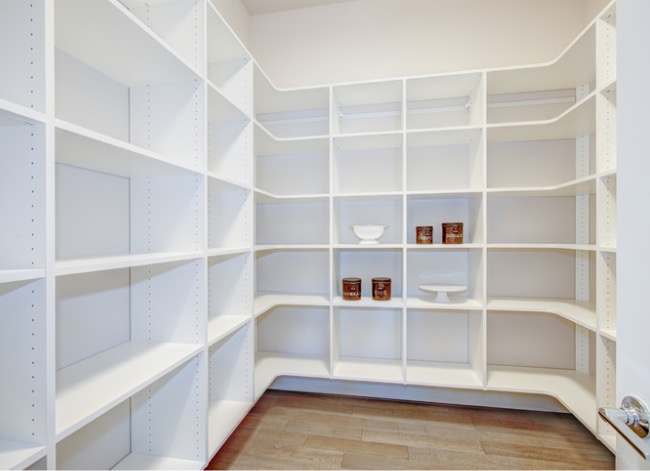
Looking for walk-in pantry shelving ideas? Organize your walk-in pantry with a shelving system that gives everything a place. When you know exactly where to find what you’re looking for, you don’t waste time looking for a particular item and you avoid re-buying items you already have. Better organization instantly makes a pantry look nicer and makes more efficient use of the vertical space that’s available. It’s a practical investment that enables you to store heavy or seldom-used items on lower shelves, and more commonly used items within arm’s reach.
2. Pocket Door
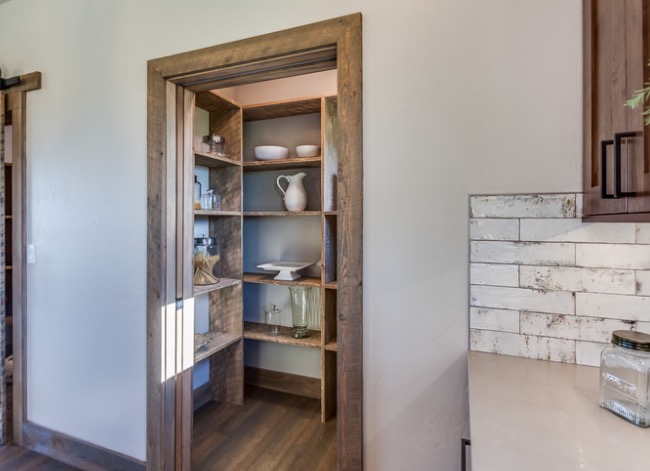
Doors on hinges may do home chefs a disservice. Unless a door is closed, it takes up more room than it needs to. This walk-in pantry idea is to swap out a traditional door with a pocket door, enabling you to keep the doorway clear without a doorstop. With a door that simply slides out of the way, you can quickly pop in and out of the pantry while preparing a meal.
3. Stand-Alone Wire Shelving

Built-in shelving looks beautiful in a walk-in pantry, but it can be a little pricey. Small or narrow walk-in pantries may not require all-around shelving, and a standalone unit works very nicely, offering extra storage in a small space. A wire shelving rack is easier to keep clean as well, as any crumbs or spice spills tend to slip through gaps and down to the floor. A quick dust and sweep keeps these shelves and the pantry looking their best. These sturdy, highly rated wire shelves are available on Amazon.
4. Stow Small Appliances
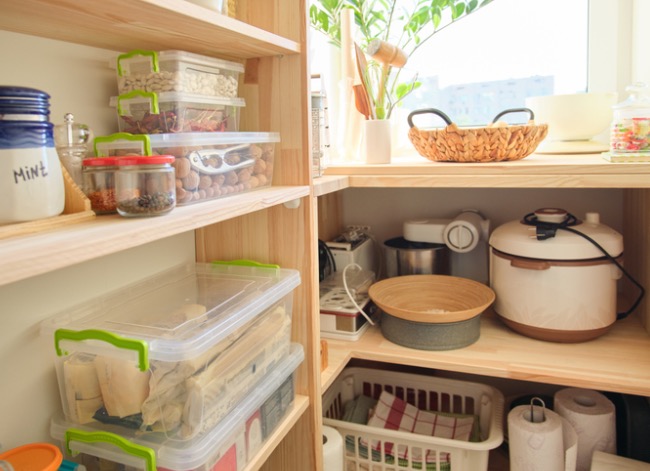
How often do you use your rice cooker or electric mixer? If it’s not an item you use daily, it’s cluttering up your countertop or taking up valuable space in your kitchen cupboards. Relocate these small appliances to a dedicated space in your pantry instead. People who have kitchens with walk-in pantries will find this idea to be a fantastic storage solution for all your kitchen gadgets that need a home.
5. Lazy Susans
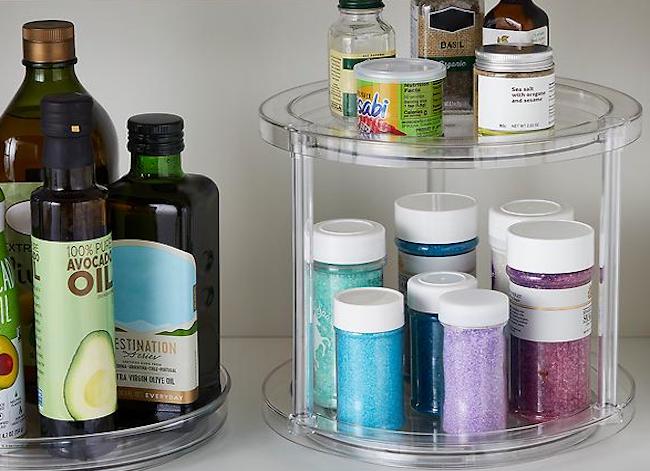
Spice jars, cooking oils, sprinkles, and other smaller bottles and containers can get lost on a jam-packed shelf. Rather than having to pull out multiple jars, cans, and bottles to get to the product you need, make your walk-in pantry more user-friendly by displaying smaller items on a lazy susan. Rotate the turntable to swiftly locate and pull out the item you need without moving other items out of the way first. These lazy susans are available from The Container Store.
6. Organize by Expiration Date

First in, first out is how restaurants and grocery stores stock their perishables. Putting older items in front of, or on top of, newer packages of the same goods ensures you’re using up the products that expire first. This type of organization saves money and generates less waste as it encourages you to use up an open package before opening a new one. Sorting your walk-in pantry this way also makes it more efficient to clean out, as you know the items on top expire first.
7. Narrow Countertop
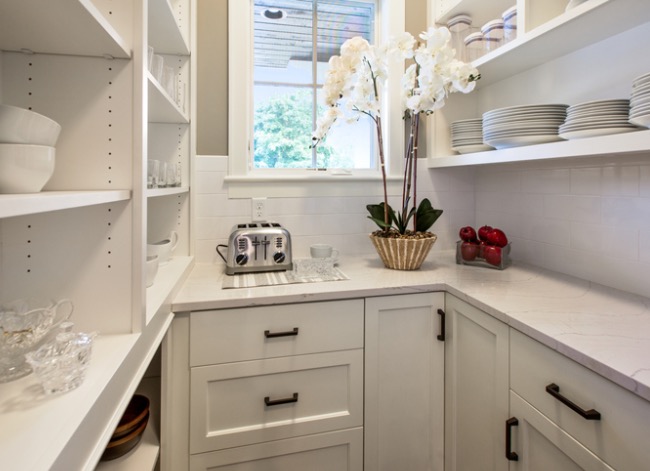
For walk-in pantries that have the space, a narrow countertop is a convenience you won’t want to be without. It also looks sharp, making your pantry resemble a kitchenette.
A countertop offers you a place for small kitchen appliances that may not be used every day, like toasters or espresso machines. It’s also a terrific place to collect and sort your items before bringing them into the kitchen, and it gives you a place to put grocery bags full of pantry supplies.
8. Cover Shelves

An affordable and easy way to freshen up the appearance of a walk-in pantry is to use a shelf liner or cover. Not just aesthetically pleasing, shelf liners can be practical too, offering a nonslip grip for your pantry items.
If you’re apt to frequently change up the look in your pantry, selecting a shelf cover that’s non-adhesive makes it easy to swap out different designs or materials. Adhesive laminate shelf liners, like this highly rated option available on Amazon, easily wipe clean with a damp cloth and brighten up the shelf space in the pantry.
9. Carry Over Your Kitchen Style

Think of your walk-in pantry as an extension of your kitchen. Creating a cohesive style that flows from your kitchen into the pantry makes a home look more elegant (and the pantry doesn’t look like an afterthought). Use the same colors, tiles, cupboards, handles, or lighting fixtures to tie the two rooms together. When your pantry reflects the same style, you’ll want to leave the door open to show off its beauty.
Related: All You Need to Know About Butler’s Pantries
10. Use the Back of the Door
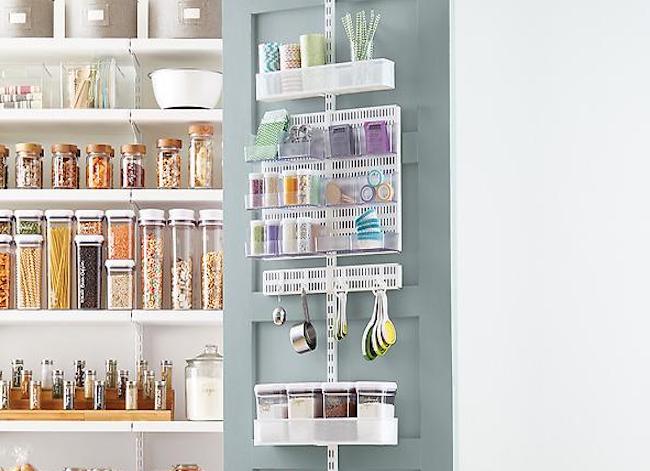
Being smart about the available space you have in your walk-in pantry means you look at all opportunities for storage—especially if the pantry is compact. If you don’t have a pocket door for the pantry, there’s usable storage space on the back of the door.
This can be a great place to add some hooks for aprons or install a door rack, which turns the area behind the door into functional space. Install this over-the-door rack from The Container Store to help fit everything you need into the pantry.
11. Decorative Kitchen-Facing Door

You’ve heard of a statement wall, but what about a statement door? Add some extra charm to the pantry with a decorative door to make it stand out from closet and washroom doors. Decorative doors come in a variety of styles and sizes, so before ordering a door, make sure it fits the doorway (also ensure you order a door that has the hardware on the correct side). One of our favorite decorative pantry doors is this one from The Home Depot.
12. Build a Closet in the Kitchen
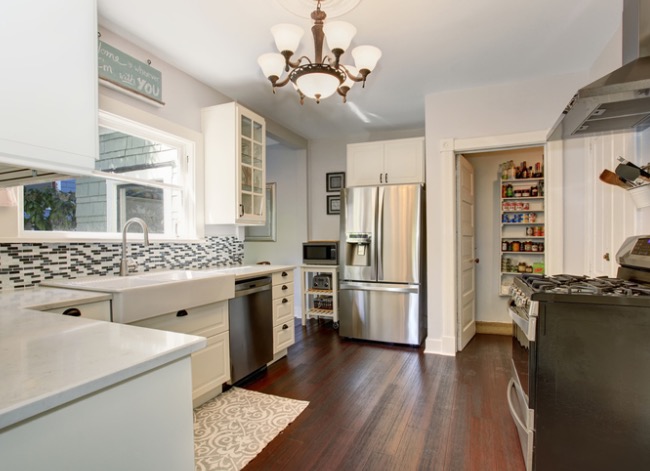
A kitchen with wasted space is a sign that an overhaul is needed. If there’s a nook, corner, or even unused space under the stairs, it can be converted into a kitchen closet, or a modest kitchen pantry. If you’re a serious DIYer, you can build a frame, install the drywall, attach the door, and all the little steps in between over a few days.
13. Cabinets and Drawers
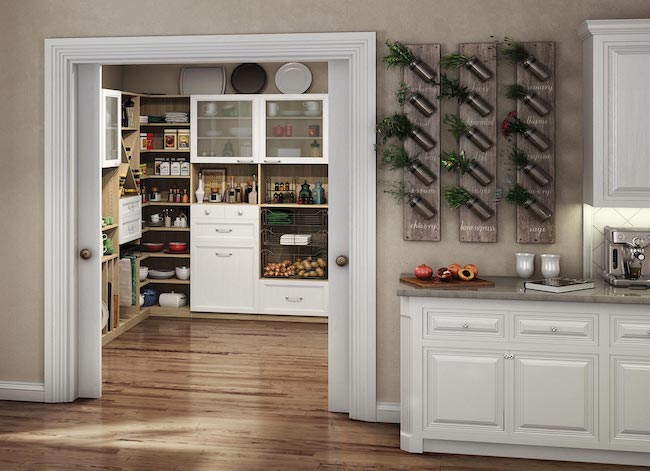
Shelving is practical, but cabinetry elevates the appearance of a walk-in pantry. Adding doors or drawers makes the pantry look less cluttered, while leaving your food supplies and kitchen gadgets easily accessible. Cabinetry that matches or complements the style in the kitchen creates a cohesive aesthetic through the home. The cabinets in the above photo are available from California Closets.
14. Don’t Overstock
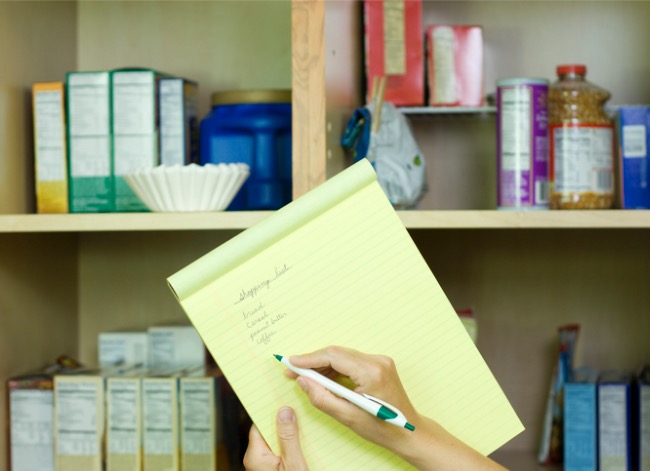
One of the great joys of a pantry is its visual nature. When preparing your grocery list, a well-organized pantry makes it easy to take stock of what you need and what you’re running low on. Organization reduces overspending and buying more than you require. Though pantries offer additional storage space, they still have limitations. Avoid stuffing your pantry with multiples of the same item to keep your pantry neat and clutter-free.
15. Clear, Stackable Food Storage

Airtight containers help keep food, spices, and baking supplies fresh. Investing in clear, stackable food storage containers is a worthwhile investment for two big reasons. One, you can see exactly how much of a particular item you have and can add any low-stock items to your grocery list. Two, stacking containers make the most of the space you have available while keeping the stacked items stable and secure. We like these highly rated OXO containers, available on Amazon.
16. Store More Spices
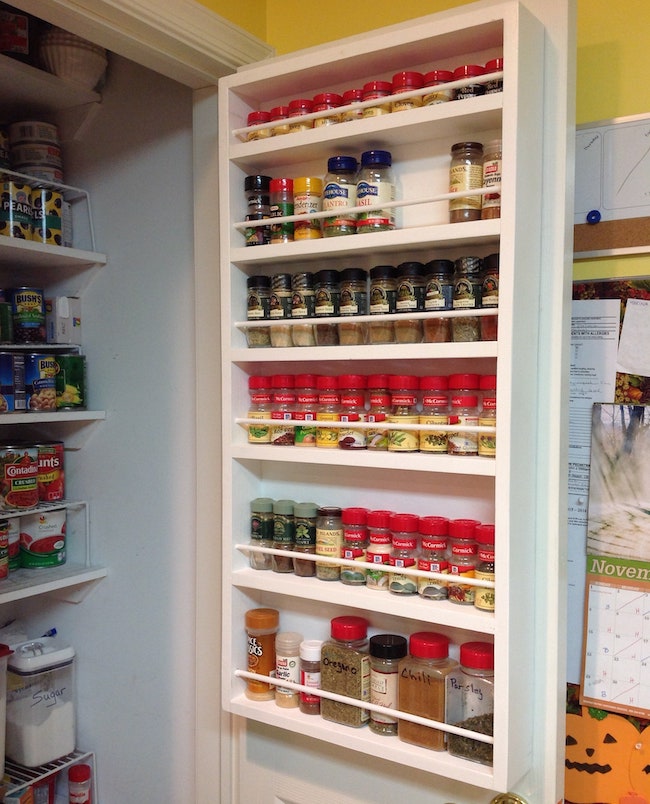
A true home chef has a vast collection of seasonings and spices to make their food memorable. But the one drawback of having so many flavors in a kitchen is having enough space for them. Storing every spice in a cupboard makes it tedious to find the one you’re looking for. Spices should be stored in a specialty spice rack so you can always find the seasoning you need. Midwest Classic Crafts’ door-mounted spice rack on Etsy enables you to store dozens of spice bottles in a convenient location in the pantry.
Related: 25 Things to Get Rid of Before 2025
17. Cart for Mobile Storage
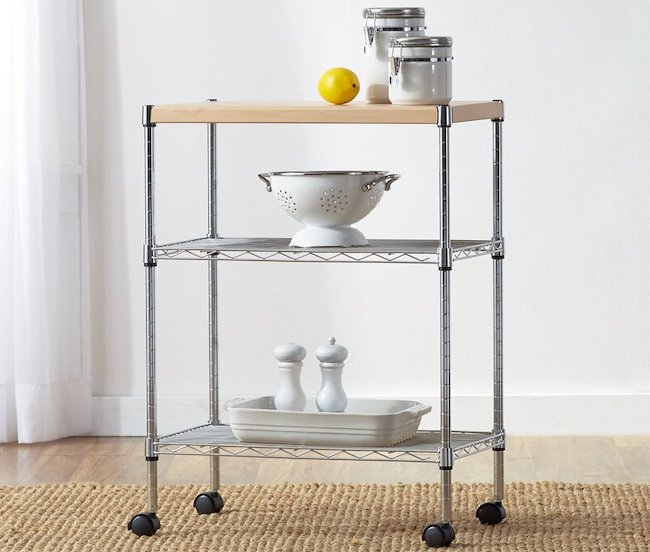
A versatile cart levels up your walk-in pantry game. Load it up with the items you need from the pantry to avoid going back and forth from the kitchen, use it as a serving caddy, or even as a makeshift drink cart when guests are over. There are a multitude of ways a pantry cart adds value and convenience to your home, and it’s one classy addition to your next dinner party. This sleek kitchen cart is available on Wayfair.
18. Ensure Adequate Lighting
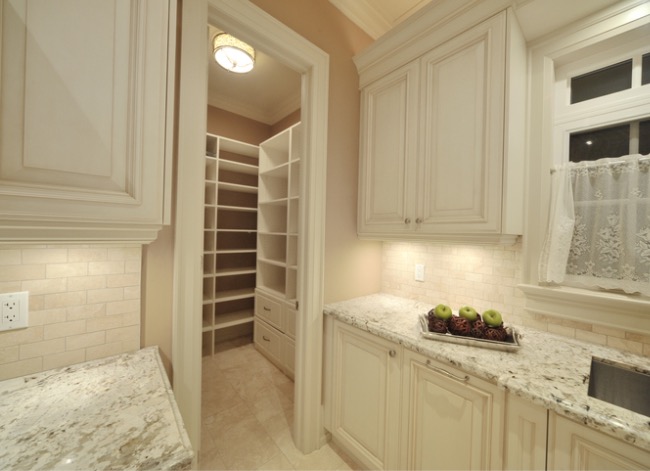
Dingy pantry lighting really puts a damper on this space. If you’re squinting to read labels, or it’s too dark to tell if the room is clean or dirty, it’s time to revamp the lighting in the pantry. It may be as simple as changing to a brighter bulb, or perhaps the entire fixture should be replaced with a stylish and bright ceiling light. Spending a little money to improve the lighting makes a tremendous difference in the pantry’s appearance.
19. Corral Fresh Produce

Having a supply of fresh produce on hand makes it easier to grab a healthy snack. Instead of overflowing the kitchen fruit bowl, store extra vegetables and fruit in the pantry. When you shop for groceries, bring along reusable produce bags to eliminate the need for plastic, and use these bags to store your bounty of produce neatly in the walk-in pantry (without the apples and oranges rolling away). You can find these reusable mesh produce bags on Amazon.
20. Keep a Step Ladder Nearby
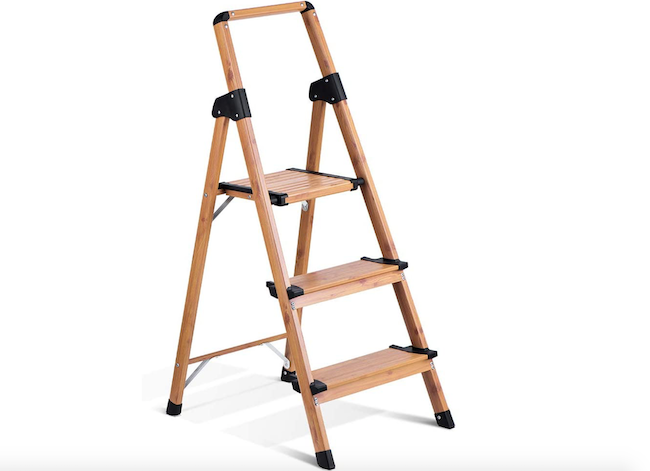
Home chefs come in all sizes, and let’s face it, some of those higher shelves are even out of reach for tall folks. When you make the most of your pantry space, your shelving and storage may put some items up high. Tucking a small step ladder into the corner of your walk-in pantry ensures you’re always able to reach what you need. We like this Delxo aluminum ladder from Amazon because it has a high weight capacity, stability, and it only weighs 9 pounds.
